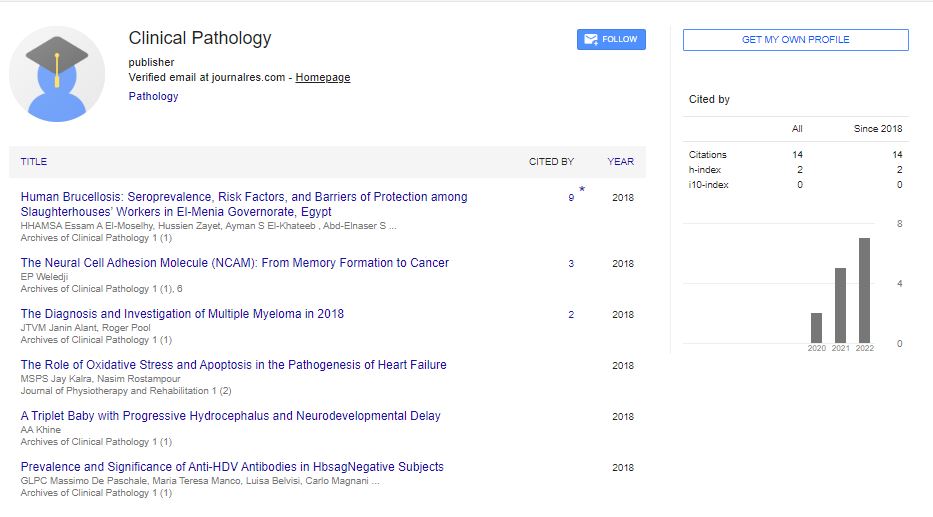LMP2/β 1i as tumor-suppressor defines new targets for uterine leiomyosarcoma therapy; PRUM-IBio study
Takuma Hayashi, Tomoyuki Ichimura, Kenji Sano, Susumu Tonegawa, Yae Kanai, Dorit Zharhary, Hiroyuki Aburatani, Nobuo Yaegashi and Ikuo Konishi
National Hospital Organization Kyoto Medical Center, Japan
Osaka City University Graduate School of Medicine, Japan
Iida City Hospital, Japan
Massachusetts Institute of Technology, USA
Keio University School of Medicine, Japan<
: Arch Clin Pathol
Abstract
Uterine leiomyosarcoma (Ut-LMS) is resistant to chemotherapy and radiotherapy; therefore, surgical interventions are virtually the only means of clinical treatment. The prognosis of patients with Ut-LMS is poor and the 5-year survival rate is approximately 35%. Uterine leiomyoma (LMA) may occur in 70-80% of women by the age of 50 years. Difficulties have been reported in distinguishing Ut-LMS from other uterine mesenchymal tumors including uterine LMA and a diagnosis generally requires surgery and cytoscopy; therefore, a diagnostic method needs to be established that can identify non-standard smooth muscle differentiation. Exosomes are lipid-bilayer-enclosed extracellular vesicles that contain nucleic acids and proteins. They are secreted from all cells and circulate in the blood. Specific detection and isolation of tumor-cellderived exosomes in the circulation is currently lacking. Using molecular analyses, our research group identifies cellular factors, which are established as potential biomarker for Ut-LMS, specifically enriched in clinical materials derived from Pts with Ut-LMS. The molecular experiments demonstrated differential expression of cyclin E and P27/KIP1 that regulate cell-cycle G1 arrest via PSMB9/b1i expression. The discovery of differential expression of factors on a key cell-signaling pathway may provide new targets for diagnostic approaches and therapeutic intervention. Efficacy and reliability of immunohistological candidate-biomarker as a differential diagnosis for uterine mesenchymal tumor have been examined by large clinical study PRUM-IBio study. We will report a part of the results of this clinical study. These studies were conducted in accordance with university ethical guidelines.
Biography
Takuma Hayashi is the Professor at Shinshu University Graduate School of Medicine since 2002 and also Section Head, National Hospital Organization Kyoto Medical Center, Japan. He has received his PhD from Institute for Medical Science, University of Tokyo in 1994. He was research training as a resident staff in Virology Division, at National Cancer Center, Tokyo Japan for 3 years until 1994 and joined Whitehead Institute (WI)/Mass.Inst.Tech. (M.I.T.). He earned postdoctoral training in the laboratory of Dr. Rick A. Young (Membership in the National Academy of Sciences, WI/M.I.T.) and also was a research member of USA Project of AIDS vaccine development (Project Leader: Dr. David Baltimore, Nobel Laureate, Cal.Tech.). After postdoctoral training, he got faculty position Lecture, Mass. General Hospital (MGH)/Harvard Medical School (HMS) in 1997. He has been studying the antigen presentation system by MHC class I with LMP2-deficient mice, under the cooperation of Dr. Susumu Tonegawa (Nobel Laureate, M.I.T.). He identifies diagnostic biomarkers, LMP2, Cyclin B1 and Cyclin E, for malignant tumor, i.e. uterine leiomyosarcoma. Current research focus: molecular approach of tumorigenesis of uterine leiomyosarcoma and ovarian cancer.
E-mail: yoyoyo224@hotmail.com
 Spanish
Spanish  Chinese
Chinese  Russian
Russian  German
German  French
French  Japanese
Japanese  Portuguese
Portuguese  Hindi
Hindi 